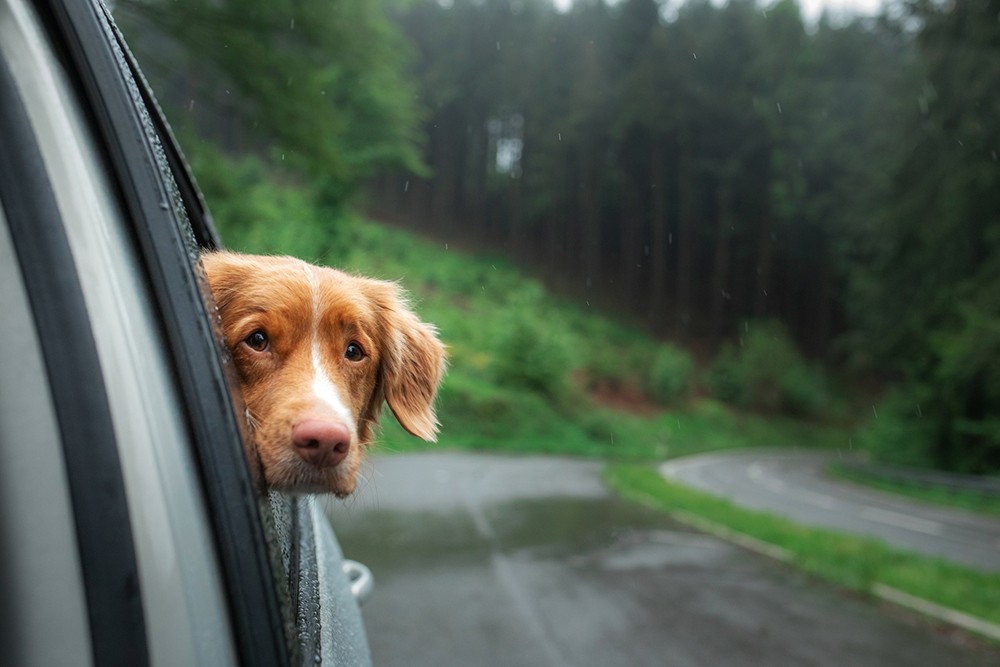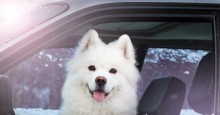
Traveling with your dog isn’t just for summer road trips, it’s an any season activity.
Winter can be a great time to travel with your pet with fewer crowds and fun playing in the snow. But traveling in the winter with your dog can come with a few challenges that are best to be aware of as you get ready for your travels.
Before you hit the road with your pooch, ensure you are well prepared with these 10 helpful tips for traveling with your dog in winter.
1. Bring proper warm winter gear
Just as you would pack a blanket and warm jacket for yourself during winter travels, do the same for your dog.
If your car were to break down or if you were to get stuck in a snowstorm, having winter weather gear such as a warm blanket and a jacket for both you and your pet is important. This is especially true for short-haired dogs. You also might want to consider packing their bed or bringing a heated bed.
2. Pet shoes
Not just as a cute accessory for your dog, pet shoes are important if you live or are traveling to an area with frequent snow and ice during winter. Shoes can help protect their paws against frostbite, and the salt or chemicals used for de-icing roads and sidewalks.
If your dog refuses to wear dog booties, the SPCA suggests massaging petroleum jelly into their paw pads before going outside. This will help protect them against frostbite and chemical agents on the ground.
Also remember, if your dog has long hair, trim down their paw hair to avoid collecting chunks of ice on their paws.

3. Pack plenty of water and food
In addition to winter weather gear, be sure to pack plenty of water and food. Bring an extra gallon of water, along with non-perishable food items. You never know when you might get stuck in a winter storm and will need to rely on your provisions.
Just like humans, pets burn more energy to stay warm in colder temperatures. According to the SPCA, pets burn extra energy by trying to stay warm.
Providing your dog with a little more food during winter travels can add some much-needed calories. As a reminder, make sure your pet is well hydrated with plenty of water as this is important for their overall health.
4. Plan plenty of pit stops
Depending on how long your drive is, plan scheduled bathroom breaks every couple of hours. Plan ahead and map out dog-friendly parks and rest stops.
Before getting out, check the ground for ice-melting products. The ASPCA’s Animal Poison Control Center classifies all ice melt products as being chemical irritants that can cause harm to your pet. So, try not to let your dog eat any of the salt or snow outside, as it may have been treated with an ice melt.
Use dog booties or petroleum jelly to help protect their paws. And bring something along like a damp towel or baby wipes to wipe their paws clean.
5. Make your stops short to avoid physical harm

Chances are if it’s too cold outside for you, it’s too cold for your dog. Avoid things like hypothermia and frostbite by making your pit stops short. According to PetMD, at-risk areas for frostbite on dogs (and cats) include the ears, nose, paws and tip of the tail.
If frostbite or hypothermia has occurred, it is best to wrap them up in a warm blanket and take them to the nearest veterinary clinic.
6. Avoid letting them off the leash
While it’s generally a good rule of thumb to keep your dog on its leash, it is particularly important in winter where there is a lot of snow. It is much easier for a dog to lose their scent during a snowstorm, so it’s best to always keep a close watch during playtime and pit stops. Plus, if they’re paws aren’t protected it is not a good idea to let them run wild.
7. Pack extra towels for your pet and your car
Keep your pet and your car clean by packing extra towels. Microfiber towels are great for cleaning up spills and any dirt or snow tracked in from the outside. Bring an extra towel for your pet as well. After your pit stops, your dog might be wet from the snow or bring in mud and slush from the outside. Using a towel not only helps keep your car clean, but it also helps keep your dog warm and dry.
Use the towel to also remove any ice, salt and chemicals from your dog’s belly and paws (if they aren’t wearing booties).
8. Keep them secure with a dog seat belt
While dog seat belts are always a good idea when road tripping with your dog, winter weather can cause hazardous driving conditions along slick roads.
Keep your pet secure with a dog seatbelt. Even the most well-behaved dog can be a distraction while driving. Plus, sudden stops during winter conditions could lead to your dog getting hurt if not properly restrained.
9. Check in with your veterinarian
Before you hit the road, it is a good idea to check in with your dog’s veterinarian a month or so prior to traveling. Make sure they are up to date on all required vaccinations and preventative care.
If it’s your first time traveling with your furry friend, take a test drive. Does your dog experience any motion sickness? Discuss this with your vet and test any motion sickness or sedative medications at home prior to heading out.
10. Schedule winter maintenance for your car
This sounds like a no brainer, but before heading out on your winter road trip, be sure to schedule a winter maintenance check up on your car. The last thing you want is to be stranded with your dog in tow on the side of the road during a winter storm.
Be sure to check your battery, tires, brakes and anything else that could be a problem in winter weather.
Copyright © 2024 by Sensible Driver. All rights reserved.